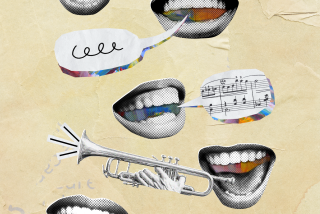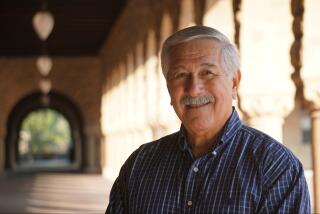Learning to Give Back
- Share via
NORTHRIDGE — Wearing dark glasses and rumpled jeans, professor Rudy Acuna strolls down the rows of his class at Cal State Northridge like a Mexican American Socrates, teasing his students, provoking them.
He knows how to rile them up and calm them down, how to pepper his lectures with colloquial Spanish to get chummy with them, then how to back off and force them to rethink everything they thought they knew.
All 26 students in his class are Latino, with maybe a few students of mixed race. The course is titled History of the Chicano but it has the feel of a United Farm Workers rally.
“Most Mexican American people felt ashamed of who they were,” Acuna said recently, referring to the time before the Chicano movement took off in the 1960s. “They used words like ‘Spanish American’ to describe themselves. And then, here comes Cesar Chavez, a little guy, 5-feet-6 and brown as all hell . . . .”
Considered the godfather of Chicano studies, the 65-year-old Acuna talks of social struggle to a generation seemingly more concerned with music videos than civil rights.
An overarching lesson woven into every class, every lecture and every dialogue in the Chicano Studies Department at CSUN is an emphasis on giving back to the Latino community. If the roster of department graduates is any indication, the efforts have paid off.
Founded in 1969 as one of the nation’s first university-level departments devoted exclusively to the study of Chicano history, literature and social sciences, the department has evolved into not only the largest ethnic studies department in the nation but an incubator for Latino political and community activism in Los Angeles and beyond.
“To my knowledge, Cal State Northridge is the largest Chicano studies department--the largest single department related to any single ethnic group anywhere in the country,” said Bob Wing, senior fellow at the Applied Research Center in Oakland, which examines race and social change.
Among those who took classes in the department are state Sen. Richard Alarcon (D-Sylmar), former San Fernando Mayor Raul Godinez, current San Fernando City Councilman Richard Ramos, and Xavier Flores, head of both the local Mexican American Political Assn. (MAPA) and Pueblo y Salud, a social service organization in San Fernando.
Walk into almost any Latino-related nonprofit group in the San Fernando Valley and there are CSUN Chicano studies graduates on staff. One-quarter of all Latino elementary school teachers in the Valley are CSUN Chicano studies graduates, according to department estimates.
“It has produced and developed a number of students who have gone out and become leaders in their own right,” said Jose Calderon, an associate professor of sociology and Chicano studies at Pitzer College in Claremont.
The department has grown from just one professor--Acuna--to 19 full- and 25 part-time professors. Acuna estimates there are 150 to 200 Chicano studies majors and 4,000 students enrolled in classes each semester, though some students may be enrolled in more than one course at a time.
The Chicano Studies Department at CSUN has grown--along with the population and political power of Latinos in Southern California--at a time when Latinos have lost ground socially. State voters over the past five years have approved three propositions that have reduced Latinos’ access to government services.
Conservative political consultant Steve Frank, a former Valley activist who now works in Ventura County, denounces Chicano studies as “Jim Crowe-ism with an accent.”
“It is an effort not to mainstream Chicano students, to keep them segregated from the rest of society,” Frank said. “Acuna is using our university in the Valley as political headquarters for efforts that demean Latino students.”
There are about 15 Chicano studies departments in the nation. Most universities, such as UC Berkeley, have ethnic studies professors grouped into a single department. Other universities, such as UCLA, have interdepartmental Chicano studies centers made up of professors tenured in other disciplines.
In 1993, students at UCLA staged a hunger strike to demand a Chicano studies department with its own faculty and curriculum. They lost that battle, leaving the university with the interdepartmental Cesar Chavez Center.
Just last week 30 students were arrested at UC Berkeley for protesting what they claim is a lack of funding for the ethnic studies department. The university has one professor of Chicano studies.
At CSUN, where there are many more Latinos, the department enjoys strong support. But history professor Albert Camarillo, director of the Center for Comparative Studies in Race and Ethnicity at Stanford University, says such departments have a responsibility to reach out to non-Latinos.
“You don’t want to just preach to the converted,” he said. “I think there needs to be a diversity of people who know about issues relating to Mexican-origin people.”
Pitzer’s Calderon says the whole point of Chicano studies programs is to raise awareness about an ethnic group that has long been overlooked. “Historically we had been left out of universities, out of the curriculum and out of history books,” he said. “If you look at it from the outside it may look separatist, but now for the first time we’re having this viewpoint represented.”
Part of the draw to Northridge’s department is Acuna, perhaps the most famous Chicano studies professor in the nation. “He had the whole crowd listening and motivated,” said student Hilda Ramirez, 22, remembering the first time she heard Acuna speak at a conference. “He talks about things that still need to be talked about, things you can’t just keep quiet about. That’s what motivates the students.”
The department has also been able to thrive because it has changed with the times, according to Wing of the Applied Research Center. In recent years, as the Central American population has soared in Los Angeles County, CSUN has hired a professor of Central American studies. One-fifth of Latino students enrolled in the Chicano Studies Department are not of Mexican origin.
More to Read
Sign up for Essential California
The most important California stories and recommendations in your inbox every morning.
You may occasionally receive promotional content from the Los Angeles Times.










